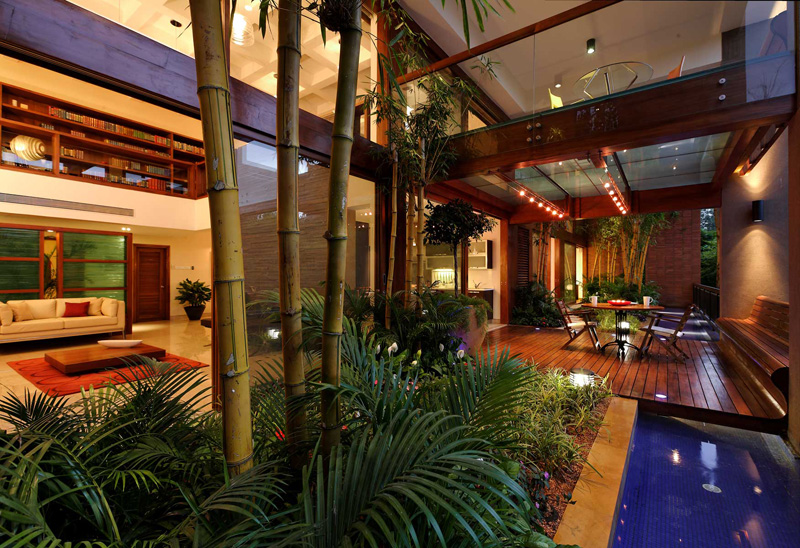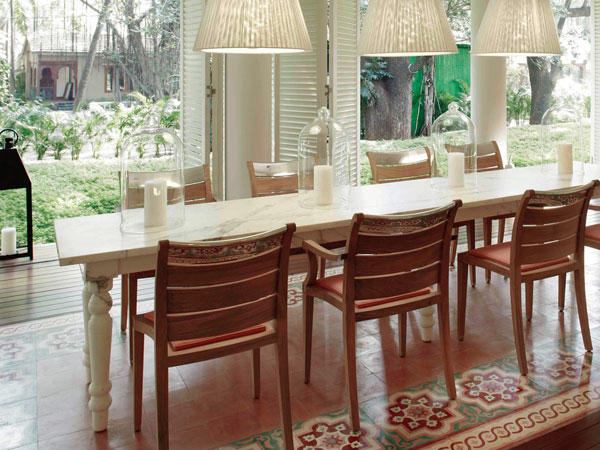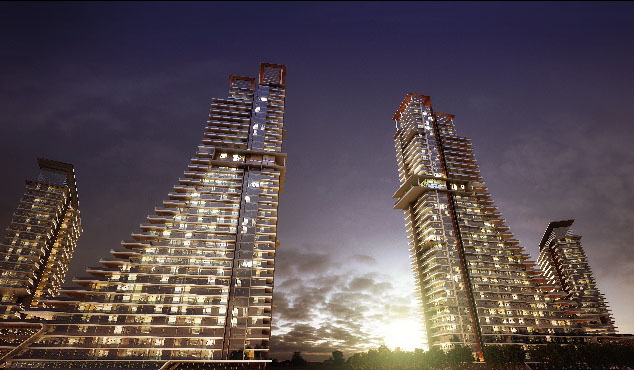Even in an economic downturn the luxury residential estate market is booming. In a series of three pieces, we look at the destinations in which you can invest in, in India and abroad. We start with India…
Windmills of your Mind, Bangalore
According to Jones Lang LaSalle’s 2013 report on the luxury market, luxury housing is emerging as one of the most vibrant real estate segments in India. The consultancy’s new Residential Index, which tracks the growth in the luxury residential market across the globe, states that Mumbai’s market for high-end apartments grew by 3.2 per cent this year.
The factors driving it: a rise in the number of High Net worth Individuals, rapid urbanization, the desire to mimic global lifestyle trends, and the emerging service industries, which have catapulted many middle income group families into the HNWIs bracket. “Besides, the recent fall in the value of Indian rupee in global financial markets has encouraged the NRI buyers to invest in the Mumbai market,” it states.
Individuals like Kapil Mehrotra, a New York-based corporate executive who says he chose to invest in a 3,000 sqft luxury property in the upcoming neighbourhood of Gurgaon, “because property prices in Mumbai never go down. And a luxury property makes sense because the amount it appreciates is at least double to the amount a regular real estate property escalates”.
According to Mehta, while a luxury apartment costs almost 30 per cent more than a premium one, the return on investment is almost 60 to 80 per cent higher.. “Cities like Mumbai and Delhi have risen in their rankings in terms of the price of prime residential properties because the city has seen a positive growth in this regard, while other international cities have seen a decline in the price of luxury residential properties,” says Samantak Das, director, research and advisory services at Knight Frank.
The Lodha Fiorenza project, at Goregaon, Mumbai
Mumbai
Among the cities with the highest real estate prices in the luxury segment is Mumbai, which is also seeing an emergence of new neighbourhoods. In Manhattan, where property prices constantly fluctuate, the creation of the High Line in 2009 completely revitalised the property market, which had stumbled over the years. The landscaped city park, created on an abandoned elevated rail tracks that stretches from Gansevoort Street to 30th Street, encouraged luxury developers to look at this traditionally neglected Manhattan neighbourhood. Property prices have jumped a mammoth 52 per cent since the High Line opened.This is the power of infrastructure projects.
Mumbai, too, is seeing an infrastructure overhaul of proportions unheard of in its last 60 year history. The result: the emergence of new neighbourhoods on the luxury residential property map. “Many of these neighbourhoods were seen as strictly off-bound for the home buyer or an investor, because they were dominated by mills, and had very little luxury infrastructure or leisure options to support it,” says Nirmal Mehta, CEO, SES Investments Ltd, who analyses and advices individuals and corporates in their real estate investments.
The axis shift towards the emerging neighbourhoods, especially for luxury properties, began almost three years ago when developers like Lodha, Ajmera, Oberoi and Bombay Realty decided to eschew the land-starved south of Mumbai location and shift to the central and the northern suburbs, to neighbourhoods like Wadala, Lower Parel, Goregaon and even Powai. What is fascinating is the transformation that the neighbourhoods, in which these modern-day palaces are being constructed, are undergoing. They were once considered not very cool by the purveyors of style and the lovers of luxury. Wadala, the location for the super-exclusive residential enclave, New Cuffe Parade (which, incidentally, is at several hundred metres distance from the ‘old’ Cuffe Parade – the bastion of old money), was known as the workers zone till early 2000, dominated as it was by factories and low-cost housing.
Aarey Milk Colony — Luxury Housing
Spinning the Web
According to Rohan Patel, CEO, M2M real estate consultancy, which is involved in the marketing and sale of some of these luxury properties, “While the metro will connect the western suburbs to Powai, making it easily accessible to investors, the monorail that connects Wadala to Sewri, the new Eastern expressway – a beautiful stretch of road that makes travel to south of Mumbai easier, the Jogeshwari-Vikhroli link road that links the eastern part of Mumbai to the western, have changed the game for luxury developers in these areas.”
Leisure options are another factor why a neighbourhood becomes attractive to a luxury property investor or buyer. “The presence of Starbucks in Oberoi mall in Goregaon (E), or of five star hotels like Westin in Goregaon, ITC Grand Maratha in Parel, and the Shangri-La in the sprawling High Street Phoenix mall, which is also a wonderful shopping destination for a connoisseur of luxury, has definitely increased the brand value of neighbourhoodlike Goregaon, Wadala, Sewri and Dadar, for investors,” says Patel. “In Goregaon (E), the beauty of the green belt across the entire stretch of the Aarey Milk Colony, makes the area appealing for the luxury consumer.”
Pune: Paradise in Peshwa-land
The transformation of the erstwhile capital of the Peshwas is apparent when you drive down from Mumbai to Pune via the expressway, which is lined with hoardings that showcase luxury condominiums and properties. “The city is a hub for young well-salaried IT professionals, businessmen and global citizens wanting a better lifestyle and looking at investments in real estate,” says Aditya Raheja, director, The Advantage Raheja Group, which is constructing a few high-end residential properties.
Amanora Gateway Towers, Pune
The turning point for Pune came when Panchshil Reality tied up with maverick American property magnate, John Hitchcox, for yoopune by Philippe Starck. The six-tower designer residential project has 228 flats, each 5,100-5,900 square feet and is located at Hadapsar. Each apartment costs around Rs 7.5 crore, and housed within the property is the country’s first Six Senses Spa.
Pune’s jumble of luxury residential complexes is concentrated in a few neighbourhoods: Hinjewadi, the city’s IT village just off the NH4 highway, has properties like Blue Ridge with a beautiful boat club and marina, a luxurious spa and top-of-the-line club house. Pimple Nilakh, on the western edge of the city, is home to KoltePatil’s sprawling 24 K Glitterati, a series of river-facing homes and duplex penthouses outfitted with a terrace deck, garden and a private pool. The eastern suburb of Hadaspar boasts the glamorous Amanora Gateway, with public spaces embellished with Swarovski crystals.
Shantanu Mazumder, branch head-Pune of Knight Frank India says, “Due to its proximity to the Mumbai-Pune expressway, areas like Hinjewadi and Pimple Nilakh, besides Baner and Aundh have seen luxury property development.” Apartments here cost Rs 10,000 sqft and more.
Bangalore: Buoyant luxury market
Karun Varma, managing director, Bangalore and Kochi, Jones Lang LaSalle, in an analysis of Bangalore’s luxury residential market says that the city’s market came of age with the Kingfisher Tower, which set new capital values benchmark, when it was priced at Rs. 30,000 per sq ft. “According to our data, capital values for residential property in Bangalore have increased by 25 per cent since the trough in mid–2009.”
Luxury Villa, Whitefield, Bangalore
The reasons for Bangalore’s buoyant luxury residential market are manifold: the ability of developers to reinvent their offers with boutique experiential spaces – imagine smart homes, apartments with private pools, and villas with extravagant landscaping and golf courses in the backyard. “The role of IT industry cannot be played down when we speak about the demand for high-end housing in Bangalore. The sizes of premium apartments in earlier times ranged between 1600-1800 sqft in emerging corridors like Outer Ring Road and Whitefield. Villas were sized at 1,800-2,200 sq ft. Then the definition of ‘premium’ changed – apartment sizes became 2,000-2,500 sqft and villas 3,000-3,500 sqft, with an accent on location. The most recent definition of premium houses in these corridors now calls for 3,000-6,000 sqft in apartments and 4,000-11,000 sqft in villa projects,” he adds.
Over the last two years, neighbourhoods and suburbs like CBD, Whitefield and north Bangalore, where the international airport has swung things in its favour have witnessed a frenzy of luxury residential developments. While Prestige’s Edwardian at Edward Road has an array of penthouses, Total Environment’s eco-luxury project, The Windmills of Your Mind is a haven for design aficionados. Its bespoke villas and circular apartments take customisation to a whole new level – choose every single thing for your villa, from the landscaping to the smart home equipment, the colours of your walls and your cabinetry.
Luxury properties are priced Rs 10 crore and above, miniscule when compared to Mumbai, but offering equal returns of about 20 to 25% appreciation on sale. Analysts estimate the luxury homes market in Bangalore to be worth $100 million. “The nascent infrastructure is a challenge,” says Raghu Menon, an analyst with city based Real Worth Consultants, who analyses real estate trends and offer advice on investments. “But many NRIs, besides a host of people from other parts of India are looking at these areas for investment.”
To be continued next week…





